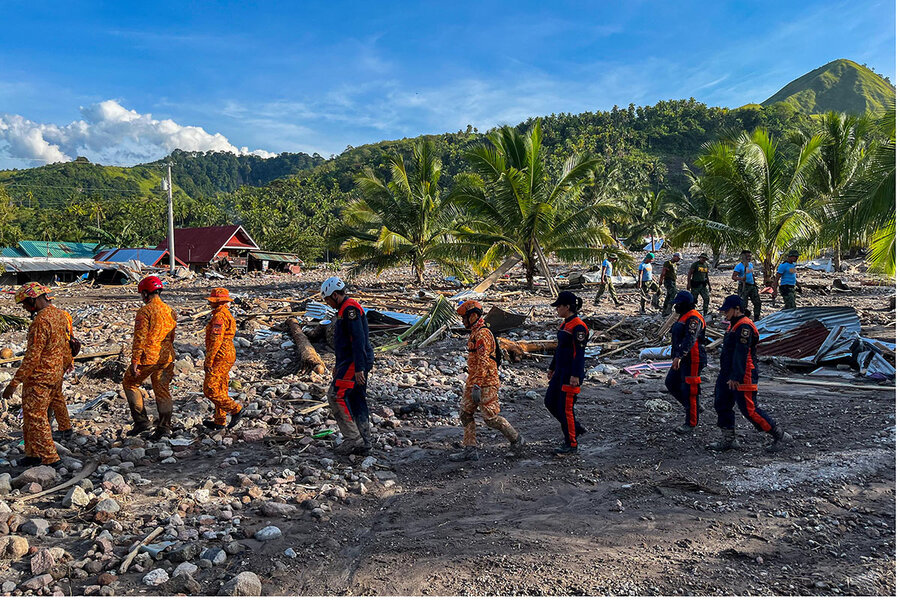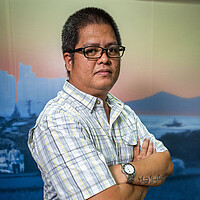In the Philippines, a deadly storm holds lessons on climate resilience
Loading...
| KUSIONG, Philippines
When news of the approaching storm arrived in Kusiong village, many of the local Teduray tribal people did as they’d practiced in annual drills: They gathered at a designated church to wait it out. But as a wave of boulder- and tree-laden mud tore through the village, that shelter became a graveyard.
It’s been a month since Nalgae dissipated, and many from the mountainside community are still missing.
Why We Wrote This
A story focused onIn the Philippines, one village’s struggle to rebuild in the aftermath of Tropical Storm Nalgae highlights the limits of climate resilience strategies. Does running from high-risk areas always make a community safer?
“We lost everything in the mudslide,” says Joan Masukat, whose daughter died during the storm.
The Teduray were relocated here from their original coastal settlement a couple of years ago by the government, at least in part to keep them safe from storm surges. As climate change fuels more extreme and erratic weather events, some experts argue the community was safer on the shore, where the threats were more familiar. Advocates say the Teduray’s plight – and that of more than 300,000 other Filipinos displaced by Nalgae – underscores a need for multihazard warning systems and better land management.
“Poor Filipino communities are generally resilient to whatever disaster that comes, because they have no choice but to adapt and survive,” says Analyn Delos Reyes Julian of Caritas Philippines, the humanitarian arm of the Filipino Catholic Church. “But we know that they deserve more than that.”
It’s been a month since Tropical Storm Nalgae triggered deadly mudslides in the southern Philippine village of Kusiong. The earth has hardened over the remnants of more than 200 Indigenous households, and the local Teduray tribal people have buried 43 of their own. More remain missing.
“We lost everything in the mudslide, our loved ones, our livelihood, our homes,” says Joan Masukat, whose 1-year-old daughter died during the storm. “Now, we have nowhere to go.”
It wasn’t supposed to be this way. A couple of years ago, the Teduray people were relocated here from their original coastal settlement by the government, at least in part to keep them safe from escalating storm surges. They now join the growing ranks of climate refugees around the world who’ve been displaced by droughts, floods, and other natural disasters.
Why We Wrote This
A story focused onIn the Philippines, one village’s struggle to rebuild in the aftermath of Tropical Storm Nalgae highlights the limits of climate resilience strategies. Does running from high-risk areas always make a community safer?
As poor and otherwise vulnerable communities bear the brunt of this year’s extreme climate events, advocates worry that disaster-resilient spaces appear to be shrinking. In the Philippines, the Teduray and climate activists are questioning the government’s climate preparedness, calling on leaders to declare a climate emergency, and looking harder at how land is managed.
“Poor Filipino communities are generally resilient to whatever disaster that comes, because they have no choice but to adapt and survive,” says Analyn Delos Reyes Julian of Caritas Philippines, the humanitarian and advocacy arm of the Filipino Catholic Church. “But we know that they deserve more than that. They should get all the help they need to get back on their feet and survive the worsening climate situation.”
Tunnel vision
Since a devastating tsunami struck their former village in 1976, the Teduray have held annual storm drills, teaching new generations how to identify the sound of an approaching wave and designating safe areas where families could wait out storms on higher ground. But they were unprepared for the geohazards that faced them at the foothills of Mount Minandar in Maguindanao del Norte province.
When news of the approaching tropical storm arrived, many gathered at a church to wait it out. As a wave of boulder- and tree-laden mud tore through the chapel, that shelter became a graveyard.
It’s not uncommon for communities to focus on one type of threat at the expense of another, experts say. In fact, a United Nations report published shortly before Nalgae made landfall on Oct. 28 warned that just over half the world’s countries lack multihazard early warning systems, making them especially vulnerable to climate disasters. Researchers state that systems which simultaneously monitor for “interrelated and cascading events are essential” as climate change fuels more extreme and erratic weather events. It’s not enough for a community to know a typhoon is coming, for example, if the real danger lies in the floods, landslides, or disease outbreaks that follow.
Maguindanao del Norte Gov. Fatima Ainee Sinsuat says these sorts of tragedies are “unacceptable.”
“We were ready for the typhoon and the storm surge, but we were not prepared for the landslide. This was the first time that it happened to us,” she says.
Mrs. Sinsuat says the local government is working to improve its disaster risk reduction program, and that authorities are “carefully identifying” a new relocation site for the Teduray people.
“But we need to be sure this time,” she says. “The new site must be safe from both landslide and storm surge.”
Seeking safe harbor
In some ways, the entire archipelago is on the front lines of the ever-worsening climate crisis, but geologist Narod Eco says safe spaces aren’t really shrinking. Rather, “there is a lack of proper land use management.”
“Land use management must primarily serve our people,” he says. “Sadly, land areas that are safe from the impact of harsh weather conditions are given to industries and businesses.”
After the storm dissipated in early November, Robinhood Padilla, senator and chair of the Committee on Cultural Communities and Muslim Affairs, announced a probe into the Teduray’s 2020 relocation, alleging they were forced out by a “powerful person” who wanted to build a resort on the community’s ancestral land.
Mayor Lester Sinsuat of the surrounding Datu Odin Sinsuat town (and husband of Mrs. Sinsuat, the governor) says the government initiated the move due to fears of another deadly tsunami.
“I relocated them because of the threat of storm surge,” he says. “There are a lot of coastal villages in our town that needed to be relocated away from the shore to prevent the loss of lives.”
Ms. Masukat, who lost her daughter, says she was grateful to the local government for moving the community away from the volatile coast, and doesn’t blame anyone for failing to predict the landslide.
“There was no precedent. Everyone thought that we were safe in our new settlement,” she says.
Still, some argue that the Teduray were safer on the coast, where the threats were more familiar.
“If there was good land use management, authorities wouldn’t have had to relocate [the Teduray people] from their original settlement near the shore. ... The government just needs to provide them safe evacuation camps and proper evacuation plans whenever there is a threat of storm surge,” says Mr. Eco.
Of the 327,048 people displaced by Nalgae, only 17,202 are staying in government-designated evacuation centers, according to National Disaster Risk Reduction & Management Council data from late November. Authorities report that more than 309,000 people remain displaced in the hardest-hit Bangsamoro Autonomous Region in Muslim Mindanao, including the Teduray tribal people in Kusiong village.
“A lot of them have set up temporary shelter along the road or near the shore while they wait for the government’s decision on their relocation,” says Ms. Julian, who recently visited the area to assess the impact of the storm on poor communities.
While internally displaced persons in Mindanao live from day to day on relief packs, the call for the Philippines to declare a nationwide climate emergency grows stronger.
Declaring a climate emergency
“For vulnerable communities to adapt and survive, the government must prepare the people,” says Ian Rivera, national coordinator of the Philippine Movement for Climate Justice (PMCJ). “The Philippines can only do this if there is a national policy that will serve as the backbone in combating the climate crisis.”
The PMCJ’s “National Campaign for the Survival of Peoples and Communities,” launched Nov. 23 during its congress in Quezon City, aims to ramp up the organization’s lobbying efforts related to climate resilience, including the declaration of a national emergency.
Several nearby nations have declared a climate emergency, such as the Maldives, Japan, New Zealand, and Singapore.
In the Philippines, local governments and educational institutions have done the same. Makati City in the capital region, and Silliman University in Dumaguete, acknowledged climate change as an existential emergency this year – both vowing to ramp up climate change mitigation efforts. But the federal government has not gone so far.
“A national climate emergency declaration will mandate every government agency to advance the welfare of the people over business interests and development projects that are destructive to the environment,” says Rodne Galicha, executive director of Living Laudato Si’ Philippines, a faith-based organization that promotes environmental sustainability.
For displaced people such as Ms. Masukat, that urgency is clearer now than ever, as she and her neighbors search for a “safe place where we can rebuild our lives.”










